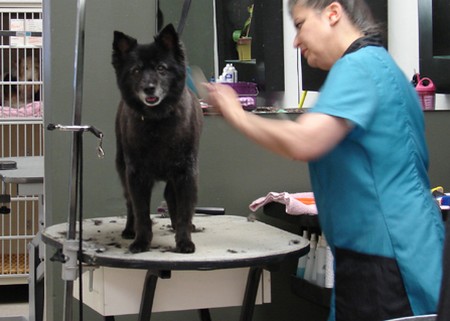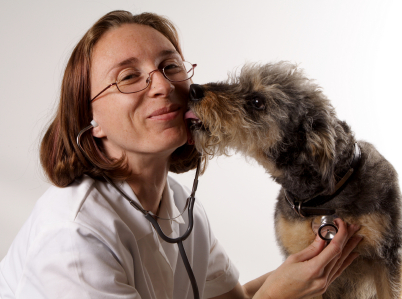Keeping an eye on your dog’s demeanour, and carrying out simple health checks on a regular basis, will enable you to monitor his state of health.
Daily checks
Some dogs are more stoical than others and will put up with considerable discomfort and pain before their owners realize something is wrong. This is why it is so essential to check your dog over thoroughly every day for any unusual lumps and sore spots. Check his eyes and mouth for foreign bodies or any sign of inflammation, and watch for irregularities in behaviour, eating and excretion.

Mouth and teeth
Dog breath should not be offensive – tooth decay is easy to diagnose because of the resulting unpleasant smell. The mouth area and tongue should be salmon pink in colour – white gums indicate anaemia, red bleeding gums are an indication of gingivitis and blue/grey gums suggest a circulatory problem. If your dog shows a reluctance to eat or drink, seek veterinary advice.
Nose, ears and eyes
The nose should be clean, slightly damp and free from discharge. The inner ear surface should be clean, smooth and odour-free. Smelly or dirty ears need veterinary investigation, as this suggests that infection is present.
The eyes should be clear, bright and free from any discharge. Some brachycephalic (broad-headed) dog breeds often suffer from eye discharge; this is a result of the skull structure being deformed, meaning that tears cannot drain away as they would normally. Tearstains can be removed with cotton wool dipped in clean, boiled and cooled water, and you can also buy proprietary tearstain removers. Any clouding of the eye surface requires veterinary attention, since this is usually the result of injury or cataract formation. The pupils should be of the same size, and the third eyelid retracted.
If the insides of the ears are looking dirty due to an accumulation of wax, but are not exuding an offensive odour (which requires veterinary treatment), simply gently wipe them with cotton wool moistened with a few drops of olive or liquid paraffin oil.
Ease of movement
Stiffness usually indicates joint problems, and limping suggests a direct pain source, such as a fractured limb, a wound, a thorn stuck in the foot pad, or an infected nail bed. A reluctance to move combined with crying out when you attempt to move the dog may be due to an internal injury or ailment.
Veterinary health checks
Choose a vet who specializes in canine health and cultivate a good relationship with them. An owner who takes their pet for regular health checks and routine vaccinations, and seeks advice on parasite control and dental care, is a valued client for whom a vet will be prepared to have more time. Keeping a diary of your dog’s behaviour and health and, therefore, being able to explain any changes you have noticed in detail, is very useful in helping your vet treat your pet appropriately and swiftly when the need arises.
Veterinary surgeries and animal hospitals have reception areas where you can make appointments, pay bills and ask for advice. Many also sell canine equipment and run puppy socialization and regular weight-watching clinics.
If for any reason you feel you would like a second veterinary opinion, then it is within your right to ask for one; no one vet knows all there is to know about their particular field of work. Your vet may even suggest that they consult another expert in order to treat your dog appropriately.
Parasite control
Dogs can suffer from a variety of external and internal parasites, including fleas, mites, lice, fungal infections, ticks and worms – all of which cause ill health. A wide variety of preparations designed to treat these parasites are available to buy from supermarkets and pet stores, but they are not as effective (nor often as easy to apply or administer) as those which are available on prescription from your vet. You must also treat other pets in the house, and the house itself, with treatments (also available from vets), or reinfestation will occur immediately. Vacuum-clean carpets and the place where your dog sleeps regularly, and wash your pet’s bedding every week or so to destroy flea eggs.
Intestinal worms (roundworm and tapeworm) are most efficiently controlled by an all-in-one treatment prescribed by your vet. Deworming products available from vets come in granule, pill, liquid or paste form.
Administering internal medication
Only give medication as prescribed or advised by your vet, and administer an medicines or pills strictly as directed.
If you are given a course of treatment for your dog, then ensure you complete it. If the treatment course is incomplete, then it is not likely to have the desired effect. This is not only a waste of your money, but your dog will continue to suffer unnecessarily. If you have difficulty getting your dog to take his medicine, then ask your veterinan practice staff for advice or help.
Liquids
Using a syringe (your vet can supply this) is often the easiest way to give liquid media to your dog. Simply insert the nozzle in the corner of the mouth and squeeze out the contents a little at a time, stroking your dog’s throat to encourage him to swallow.
Pills
Some dogs will eat pills straight from your hand, or embedded in a morsel of tasty food. If these cannot be given in food, then follow these steps:
- hold your dog firmly.
- tip back his head.
- open his mouth.
- pop the pill at the back of his throat.
- close his mouth.
- stroke his throat to encourage him to swallow the pill
Applying topical (external) treatments
Only use treatments prescribed or advised by your vet, and apply them strictly directed. When administering drops or ointment to the eyes, hold the dog’s head still (or get someone to hold him for you) and aim for the centre of the eye, or wherever directed by your vet.
To apply ear drops, hold the head still, squeeze in the drops as directed, then gently massage the base of the ear to ensure the liquid is evenly distributed on the affected area. When applying ointment to wounds, gently massage it into the affected area with a clean finger. In cases of zoonotic diseases, wear rubber or plastic gloves for each topical application and dispose of them safely in the rubbish bin afterwards.

Vaccinations
Dogs, like every other mammal, are susceptible to certain viral diseases, some of which can prove fatal. While they will not pass these on to humans (apart from rabies), they will transfer them to other dogs, and also cats in the case of the Bordetella bronchiseptica (Bb) bacterium (responsible for kennel cough). It is advisable to have your dog vaccinated for the following reasons:
- to help prevent life-threatening disease.
- to help prevent spread of disease.
- to help eliminate canine viral diseases.
- to enable you to book your dog into a boarding kennels when you go on vacation
- to enable you to travel abroad with your dog if required.
- to enable you to enter your dog into dog shows and agility competitions.
When to vaccinate
Vaccinations are given by injection (except the kennel cough vaccine which is squirted up the nose to protect against Bb bacteria and the para-influenza virus; the latter is also contained in the annual booster injection). Puppies and dogs that have not been vaccinated before need an initial course of vaccinations, comprising two injections 2-4 weeks apart. The second jab cannot be given before 10 weeks of age, but the first can be given as early as 6 weeks. Multiple vaccines are usually given in one injection which protects the dog against:
- canine distemper (D)
- canine adenovirus (CAV-2; hepatitis; H)
- parvovirus(P)
- para-influenza (Pi)
- leptospirosis
Immunity for distemper and hepatitis lasts longer than immunity for the other diseases, so an alternating booster jab programme is usually employed whereby immunity to the DHPPi components are given one year and only the PPi and L components the following year. The rabies jab is given separately – routinely in some countries, but not in others that are rabies-free. However, a rabies vaccination is required when taking your dog abroad.